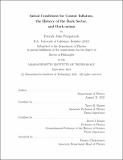Initial Conditions for Cosmic Inflation, the History of the Dark Sector, and Dark-Onium
Author(s)
Fitzpatrick, Patrick John
DownloadThesis PDF (16.81Mb)
Advisor
Slatyer, Tracy R.
Kaiser, David I.
Terms of use
Metadata
Show full item recordAbstract
The question remains whether inflation is robust to inhomogeneous initial conditions. This thesis first describes the basics of cosmic inflation and the evolution of primordial inhomogeneities in the matter field and spacetime metric during inflation. Then a new approach for analyzing the onset of inflation amid backreaction from significant inhomogeneities is presented. This new approach incorporates certain nonlinear interactions among the coupled degrees of freedom by using the nonperturbative Hartree approximation. Results applying this approach to a single-field inflationary model find inflation to be robust for large-field models.
The particle nature of dark matter is still a mystery. This thesis very briefly summarizes what we know about dark matter and our current efforts to detect it. This thesis also provides the basic tools necessary to calculate the thermal history of the dark sector. Then the results for a full exploration of the thermal freezeout histories of a vector-portal dark matter model, in the region of parameter space in which the ratio of masses of the dark photon 𝐴′ and dark matter 𝜒 is in the range [formula], are presented. The temperatures of all species are carefully tracked, relaxing the assumption of previous studies that the dark and Standard Model sectors remain in thermal equilibrium throughout dark matter freezeout. A rich set of novel pathways which lead to the observed relic density of the dark matter is revealed. This thesis also examines the [formula] regime of the vector-portal inelastic dark matter model, where the dark matter is made up of a Majorana ground state 𝜒 and excited state 𝜒 * with a small mass splitting between them, carefully tracking the dark sector temperature throughout freezeout. The inelastic nature of the dark sector relaxes stringent cosmic microwave background and self-interaction constraints compared to symmetric dark matter models.
The spectrum of Weakly-Interacting-Massive-Particle (WIMP) dark matter generically possesses bound states when the WIMP mass becomes sufficiently large relative to the mass of electroweak gauge bosons. After a review of the treatment of bound states in quantum electrodynamics, this thesis examines the formation and decay of bound states for dark matter inhabiting a more general nonabelian dark sector. The rate for SU(2) triplet dark matter (the wino) to bind into WIMPonium, and rates for the subsequent decays of these bound states, are computed. Results with applications beyond the wino case, e.g. for dark matter inhabiting a nonabelian dark sector, are also presented.
Date issued
2021-09Department
Massachusetts Institute of Technology. Department of PhysicsPublisher
Massachusetts Institute of Technology